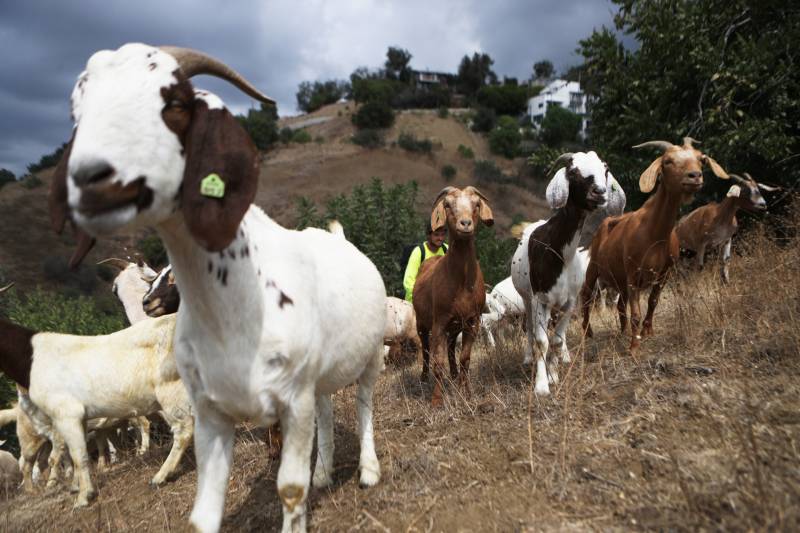California has gone through several difficult fire seasons in recent years. Now, some cities are investing in unconventional fire prevention methods, including goats.
Anaheim, a city southeast of Los Angeles, has recently re-upped its contract with the company Environmental Land Management to keep goats grazing on city hillsides nearly year-round.
The goats are stationed in places like Deer Canyon Park, a nature preserve with more than a hundred acres of steep hills. Beginning in July, roughly 400 goats worked through the park, eating invasive grasses and dried brush.
The company’s operations manager Johnny Gonzales says that Deer Canyon, with its peaks and valleys, is just the right kind of place to use goats for fire prevention.
“This is the topography that poses challenges during these wildfire events,” Gonzales says. “And we can go ahead and reduce the fuel loads and take out the invasive plants, and establish the native plants on these banks; you’re re-establishing the ecology.”
Gonzales says that demand for wildfire prevention goats has soared in recent years.
“It’s not an underestimation to say that we got over 100 calls a month from private individuals with smaller parcels, little lots or things from an acre, two acres requesting the goats,” Gonzales says. “And unfortunately, as a commercial herd, I can’t take on all these private lots.”
Nature’s weed wacker
Anaheim’s Fire Marshall Allen Hogue says the steepness of the hills in parts of the city makes the goats invaluable for landscape management.
“It would be almost impossible for a human to sit there or walk up and down with a weed whacker or a weed eater, so that’s why we use the goats,” Hogue says.
What makes the goats important isn’t just their ability to climb steep hillsides. According to Hogue and Gonzales, the animals eat invasive plants and grasses while only minimally grazing on native plants.
A recent study from the University of Massachusetts Amherst found that these alien grasses are increasing the frequency of wildfires because of how easily they burn.
“If you throw a bunch of matches into a forest, some small percentage of them might actually start a fire,” says Bethany Bradley, professor of environmental conservation at UMass Amherst and co-author of the study, “but if you throw a bunch of matches into a big hay pile, there’s a good chance that many of those will catch fire.”
The study found that these alien grasses double or triple the likelihood of a fire occurring if they’re present.
While this particular study didn’t measure the change in invasive plant abundance, researchers have found that climate change has made it easier for these plants to spread. These flammable grasses outgrow native plants that are naturally more fire-resistant, which adds potential fuel to fires.
A year-round problem
Even a particularly rainy year doesn’t help slow down a fire season. Bradley says that water helps these invasive plants grow year after year. There’s no easy fix for breaking the invasive plant cycle.
“So this is one of the biggest challenges with invasive species,” Bradley says. “Like any home gardener knows that you can’t just go out and weed once, declare victory and leave, right?”
This is where goats can play a role, according to Bradley.
“Goats are really good at eating stuff, right? The challenge with them though, is that you can’t just do it once. They need to go back time and time again in order to keep controlling that biomass,” she says.
However, not all researchers are convinced. Some like Jon Keeley from the U.S. Geological Survey think that using goats alone as fire prevention isn’t enough.
“One of the things that concerns some people is there is this feeling oftentimes that if you’re using goats to graze these invasive grasses, you’re somehow making the environment safer for communities and for homes,” Keeley says. “And that’s debatable.”

